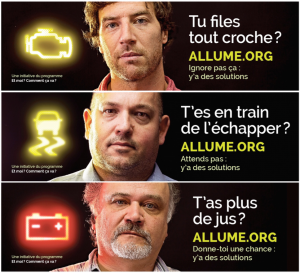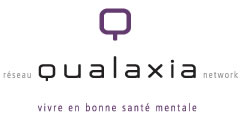
Social marketing: creativity in support of mental health promotion
In Quebec, there are many ad campaigns designed to reduce the stigma surrounding mental illness. Of particular note are ads by the Mental Illness Foundation. The campaign Demander de l’aide, c’est fort! by the Centre de prévention du suicide du Saguenay-Lac-Saint-Jean also seeks to shatter the image that asking for help is a sign of weakness, redefining it instead as a sign of strength. This type of innovation is reflected in the Et moi, comment ça va?[1] project recently established by the Centre de prévention du suicide de Québec (CPSQ). This campaign took place in the Québec City region between the end of December 2013 and mid-February 2014, with billboards and radio spots directing people to the organization’s website www.allume.org.

The CPSQ worked with researchers specializing in men’s health from the École de service social at the Université Laval as well as a communications agency. This project is specifically aimed at men between the ages of 35 and 49 who tend to identify to traditional male roles for whom access to a resource and support network is more difficult. A higher suicidal risk can be observed in this group as well as a higher level of resistance to asking for help, to prevention, and to health promotion. Since acting before a suicide crisis is crucial, the campaign builds on the positive aspects of masculinity, such as a sense of responsibility and autonomy, to promote solutions that correspond to this group’s reality in a genuine and straightforward way.
Maintaining a constant and open dialogue between researchers, health care providers, and advertisers is fundamental to ensure that creativity can be put to full and good use in the promotion of mental health. The main challenge facing researchers and health care providers is a tendency to over intellectualize the ads. In this respect, striking the right balance requires a steady, reflective approach. In the case of advertisers, the challenge consists in efficiently presenting theoretical concepts using non-technical terms and developing an advertising concept that is consistent with accepted practices in health promotion. An essential condition of fruitful collaboration also requires that everyone’s respective expertise be acknowledged. During the regional campaign, we were expecting around 3,000 hits on the site, but over 20,000 have already been recorded since the launch. The evaluation of the current campaign will teach us a bit more about its impact. In short, this is a perfect opportunity to appreciate the way in which creativity and complementary expertise can be put to good use in developing new strategies to reach this vulnerable, marginalized clientele as well as those who don’t feel that traditional health promotion campaigns are meant for them.
[1] The campaign is funded by the Foundation of the CPSQ and AstraZeneca.
|
|
|





Leave a comment
Your email address will not be published.